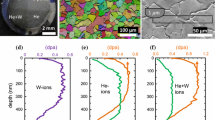Abstract
The nanoindentation fracture behavior of gallium arsenide (GaAs) is examined from two perspectives in two parent papers. The first paper (part I) focuses on in situ nanoindentation within a scanning electron microscope (SEM) and on fractographic observations of cleaved cross-sections of indented regions to investigate the crack field under various indenter geometries. In the second parent paper (part II), cathodoluminescence and transmission electron microscopy are used to investigate the relationship between dislocation and crack fields. The combination of instrumented in situ scanning electron microscopy nanoindentations and cleavage cross-sectioning allows us to establish a detailed map of cracking in the indented region and cracking kinetics for conical and wedge indenter shapes. For wedge nanoindentations, the evolution of the half-penny crack size with the indentation load is interpreted using a simple linear elastic fracture model based on weight functions. Fracture toughness estimates obtained by this technique fall within the range of usual values quoted for GaAs.




















Similar content being viewed by others
References
K. Wasmer, C. Pouvreau, J-M. Breguet, J. Michler, D. Schulz, and J. Giovanola: Nano-indentation cracking in gallium arsenide: Part II: TEM investigation. J. Mater. Res. 28(20), 2799–2809 (2013). DOI: 10.1557/jmr.2013.275
D. Scannell and D. Smith: Scribing Compound Semiconductors: An Application Primer, ed. Karl Suss, Suss Report, 1987.
J.W. Ure: Application of Scribing to Optoelectronic Devices, ed. Karl Suss, Suss Report, 1988.
Loomis Industries: A Fresh Perspective on Scribing and Breaking Applied to Semiconductor Wafer Processing, (2006). www.loomisinc.com.
K. Wasmer, C. Ballif, R. Gassilloud, C. Pouvreau, R. Rabe, J. Michler, J.M. Breguet, J-M. Solletti, A. Karimi, and D. Schulz: Aspects of cleavage fracture of brittle semiconductors from the nanometre to the centimetre scale. Adv. Eng. Mater. 7, 309 (2005).
K. Wasmer, C. Ballif, C. Pouvreau, D. Schulz, and J. Michler: Dicing of gallium-arsenide high performance laser diodes for industrial applications: Part I: Scratching operation. J. Mater. Process. Technol. 198, 114 (2008).
K. Wasmer, C. Ballif, C. Pouvreau, D. Schulz, and J. Michler: Dicing of gallium-arsenide high performance laser diodes for industrial applications: Part II: Cleavage operation. J. Mater. Process. Technol. 198, 105 (2008).
C. Pouvreau, K. Wasmer, J. Giovanola, J-M. Breguet, J. Michler, and A. Karimi: In-situ scanning electron microscope indentation of gallium arsenide. In 16th European Conference on Fracture (ECF16), Proceedings of the 16th European Conference of Fracture, Alexandroupolis, Greece, July 3-7, 2006, ed. E.E. Gdoutos. (Springer, New York, NY, 2006).
R. Rabe, J-M. Breguet, P. Schwaller, S. Stauss, F-J. Haug, J. Patscheider, and J. Michler: Observation of fracture and plastic deformation during indentation and scratching inside the scanning electron microscope. Thin Solid Films 469–470, 206 (2004).
B. Lawn: Fracture of Brittle Solids, 2nd ed. (Cambridge University Press, Cambridge, UK, 1997).
R. Rabe: Compact test platform for in-situ nano-indentation and scratching inside a scanning electron microscope. Ph.D. Thesis, Ecole Polytechnique Fédéral de Lausanne (EPFL), 2006. http://infoscience.epfl.ch/record/86070 Library of EPFL.
A. Lefebvre, Y. Androussi, and G. Vanderschaeve: A TEM investigation of the dislocation rosettes around a Vickers indentation in GaAs. Phys. Status Solidi A 99, 405 (1987).
E. Le Bourhis, L. Largeau, G. Patriarche, and J.P. Riviere: Deformations of (011) GaAs under concentrated load. J. Mater. Sci. Lett. 20, 1361 (2001).
H.S. Leipner, D. Lorenz, A. Zeckzer, H. Lei, and P. Grau: Nanoindentation pop-in effect in semiconductors. Physica B 308–310, 446 (2001).
E. Le Bourhis and G. Patriarche: Plastic deformation of III-V semiconductors under concentrated load. Prog. Cryst. Growth Charact. Mater. 47, 1 (2003).
K. Wasmer, M. Parlinska-Wojtan, R. Gassilloud, C. Pouvreau, J. Tharian, and J. Michler: Plastic deformation modes of gallium-arsenide in nanoindentation and nanoscratching. Appl. Phys. Lett. 90, 031902 (2007).
M. Parlinska-Wojtan, K. Wasmer, J. Tharian, and J. Michler: Microstructural comparison of material damage in GaAs caused by Berkovich and wedge nanoindentation and nanoscratching. Scr. Mater. 59, 364 (2008).
R.F. Cook and G.M. Pharr: Direct observation and analysis of indentation cracking in glasses and ceramics. J. Am. Ceram. Soc. 73, 787 (1990).
K. Wasmer, M. Parlinska-Wojtan, S. Graça, and J. Michler: Sequence of deformation and cracking behaviours of gallium-arsenide during nano-scratching. Mater. Chem. Phys. 138, 38 (2013). https://doi.org/10.1016/j.matchemphys.2012.10.033.
T. Fett and D. Munz: Problems in fracture mechanics of indentations cracks. Forschungszentrum Karlsruhe, Institut für Materialforschung, FZKA 6907, (2003). http://bibliothek.fzk.de/zb/berichte/FZKA6907.pdf.
T. Fett and D. Munz: Stress Intensity Factors and Weight Functions, 1st ed. (KIT Press, Karlsruhe Institute of Technology, Karlsruhe, Germany, 1997).
G. Michot and A. George: Fracture toughness of pure and in doped GaAs. Scr. Metall. 22, 1043 (1988).
K. Yasutake, Y. Konishi, K. Adachi, K. Yoshii, M. Umeno, and H. Kawabe: Fracture of GaAs wafers. Jpn. J. Appl. Phys. 27, 2238 (1988).
C.P. Chen and C.J. Morrissey: Evaluation of GaAs fracture mechanics. Nasa Technol. Brief 11, 1 (1987).
R.W. Margevicius and P. Gumbsch: Influence of crack propagation direction on 110 fracture toughness of gallium arsenide. Philos. Mag. A 78, 567 (1998).
Author information
Authors and Affiliations
Corresponding author
Additional information
Address all correspondence to this author.
Both authors have contributed equally to this work.
Rights and permissions
About this article
Cite this article
Wasmer, K., Pouvreau, C., Breguet, JM. et al. Nanoindentation cracking in gallium arsenide: Part I. In situ SEM nanoindentation. Journal of Materials Research 28, 2785–2798 (2013). https://doi.org/10.1557/jmr.2013.252
Received:
Accepted:
Published:
Issue Date:
DOI: https://doi.org/10.1557/jmr.2013.252



